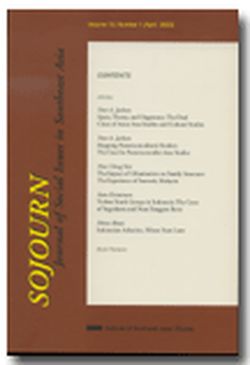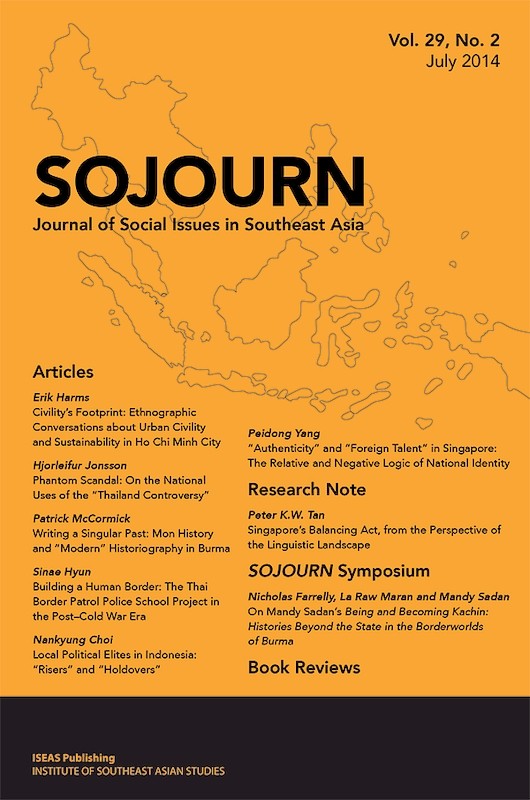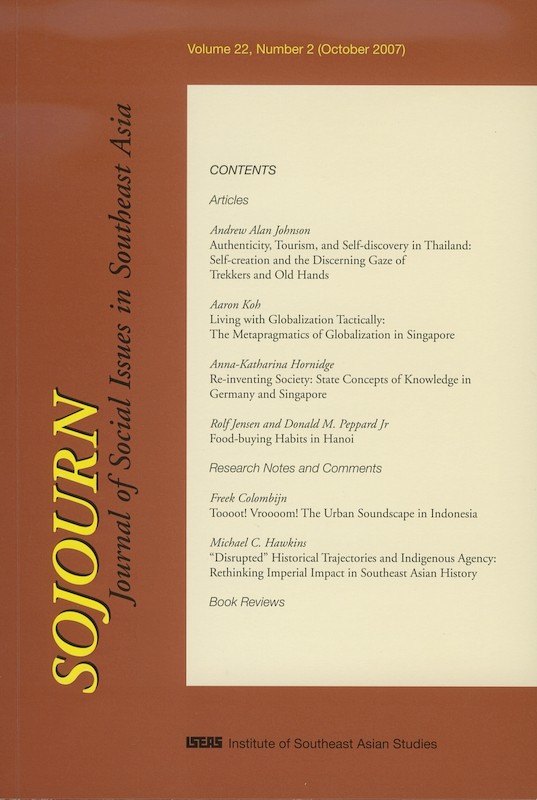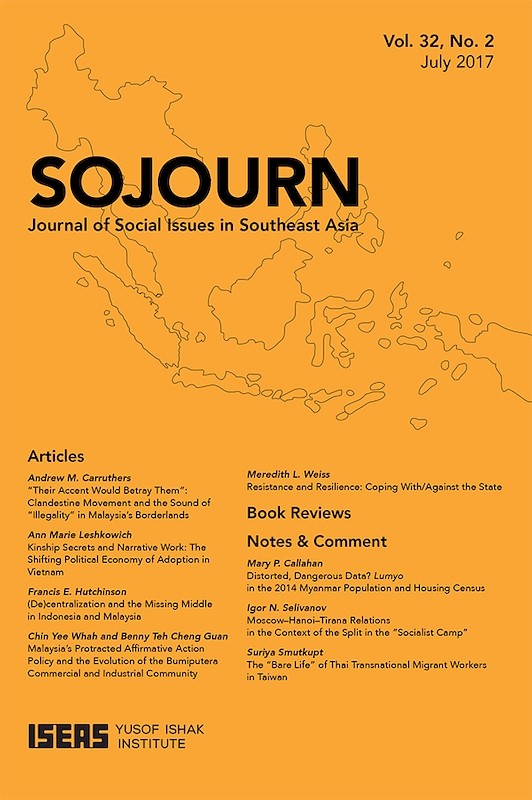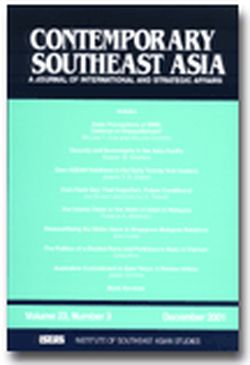SOJOURN: Journal of Social Issues in Southeast Asia Vol. 18/2 (Oct 2003)
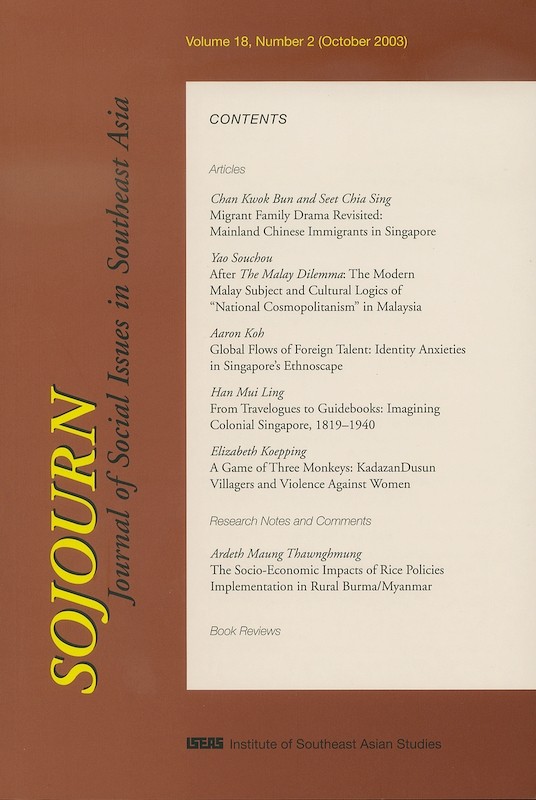
Date of publication:
November 2003
Publisher:
Institute of Southeast Asian Studies
Number of pages:
168
Code:
SJ18/2
Contents
-
SOJOURN: Journal of Social Issues in Southeast Asia Vol. 18/2 (Oct 2003)
-
Preliminary pages
- ARTICLES
-
Migrant Family Drama Revisited: Mainland Chinese Immigrants in Singapore, by Chan Kwok Bun, Seet Chia Sing, authors see abstractThis paper attempts to unfold the drama of mainland Chinese migrant families in Singapore in terms of their gender and generation politics -- the interpersonal as well as role conflicts within the domestic domain as they were engendered and negotiated during the migration process. The better life promise of migration for each and every family member was scrutinized -- each time gazing at a different member in the context of his or her institutionalized position in the family. As it happened, divided rather than common interests emerged. Not all benefited from moving. Yet all were convinced of the family having made the right move. The social construction of the family was further strengthened by transnationalism, which reproduced the reality of family solidarity through mundane everyday life activities acted out across borders. But when internalized as a construct, an ideal, the family bonded its members -- thus its internal cohesiveness. It also bound and controlled the self. Sure there were gains, but there were also losses, especially on the part of the less powerful. Globalization and transnationalism have yet to fulfill their promises.
-
After The Malay Dilemma: The Modern Malay Subject and Cultural Logic of "National Cosmopolitanism" in Malaysia, by Yao Souchou, author see abstractMalaysian Prime Minister Dr Mahathir's The Malay Dilemma has provided the ideological foundation of the pro-bumiputera policy; it is for that reason worth re-reading. The paper will deconstruct the authorial desire of the text in order to excavate the psychological depth of Dr Mahathir's understanding of the the problem facing the Malays. The relentless othering of the Chinese, I argue, creates a cul-de-sac in the Malay subject whose socioeconomic arrival is finally measured by the achievement of the Other. Both Malay marginalization and Chinese excessive endowment are constructions for making the truth claims about cause and origin of Malay backwardness. In this context, the new Malay subjectivity embodied in the Melayu Baru strikes precisely against this self-identification vis-Ã -vis the Chinese Other. More than that, as a new class located in capitalist modernity, the New Malays expresses a new and located cosmopolitanism characterized by going beyond the traditional ethnic binary of us versus them, Malay versus non-Malay, so central to the ruling UMNO ideology. This nascent sensibility of national cosmopolitanism, it is ardently hoped, will be a beginning of the rupture of the terse antagonism of ethnic relations in Malaysia.
-
Global Flows of Foreign Talent: Identity Anxieties in Singapore's Ethnoscape, by Aaron Koh, author see abstractThis paper draws on Appadurai's (1996) concept of ethnoscapes -- the global flow of people or what has become increasingly popularized as the global flow of talent. Singapore has initiated a foreign talent policy to compete for a global pool of talent to make up for its shortfall of indigenous work-force. The rationale for recruiting foreign talent is informed by a nationalist competitive ideology to sustain Singapore in the new knowledge-based economy. This paper examines the competing and dissenting discourses surrounding the foreign talent policy. It argues that the mobility of migratory flow has transformative and disruptive effects at the level of culture and the identity landscape of Singapore, where its discursive cultural boundaries are drawn according to a nationalist framework. Drawing on theories and concepts of diaspora, hybridity, and third space, these are the political and cultural issues that this paper attempts to tease out.
-
From Travelogues to Guidebooks: Imagining Colonial Singapore, 1819-1940, by Han Mui Ling, author see abstractPeople come to know about places in a variety of ways, among which the most important and highly valued is through travel. Travel experiences seldom occur in a vacuum, but, instead are filtered through preconceived images and expectations. Moreover, even though these images or travel representations may or may not be congruent with the actual experiences, they, nevertheless, give rise to a definition of the place as an entity with an identity, spirit, and personality internal to itself. In this paper, I examine travel representations of Singapore (18191940) produced by the two genres -- travelogues and guidebooks. By doing so, I hope to show how these discourses are instrumental in the constitution of the colonial geo-body of Singapore.
-
A Game of Three Monkeys: Kadazan Dusun Villagers and Violence Against Women, by Elizabeth Koepping, author see abstractBased on detailed and long-term anthropological research among rural Kadazans, the paper sets out the social history of domestic violence in one Sabah village. In more than 30 per cent of the households, there is a woman who has experienced repeated spousal abuse during her life. Adding those men who abused earlier spouses, and adults who lived through the abuse of their mothers in childhood, it is clear that violence is and has long been part of everyday yet secret village experience. For various reasons, researchers appear to have colluded in ignoring the issue. To help those women and their children whose lives are blighted by fear and fearful memories, it would be wise to assume domestic violence is as present in rural as in urban settings.
- RESEARCH NOTES AND COMMENTS
-
The Socio-Economic Impacts of Rice Policies Implementation in Rural Burma/Myanmar, by Ardeth Thawnghmung, author see abstractThis paper, focusing on two rice-farming villages where the Burmese government has experimented with a variety of agricultural programmes, explores the problems associated with rice implementation processes. In particular it looks at the basic structure and operation of agricultural administration -- salary and income of government officials, the predominance of military officers in civilian ministries and departments, the creation of departments with overlapping responsibilities, and the hierarchical structure of the Agricultural Ministry -- and highlight their limitations. It provides another aspect to evaluating the roots of poverty among average rice farmers.
- BOOK REVIEWS
-
BOOK REVIEW: A Country in Despair: Indonesia between 1997 and 2000. By Kees van Dijk. Leiden: KITLV Press, 2001. 621 pp., by Anthony L Smith, author
-
BOOK REVIEW: Identits en regard: Destins chinois en milieu bouddhiste tha. By Bernard Formoso. Paris: CNRS Editions/Éditions de la Maison des sciences de lhomme, 2000. 288 pp., by Jean Debernardi, author
-
BOOK REVIEW: The Thai Village Economy in the Past. By Chatthip Nartsupha. Translated by Chris Baker and Pasuk Phongpaichit. First published 1984. Reprint ed. Chiang Mai: Silkworm Books, 1999. 131 pp., by Katherine Bowie, author
-
BOOK REVIEW: Chinese Populations in Contemporary Southeast Asian Societies: Identities, Interdependence and International Influence. Edited by M. Jocelyn Armstrong, R. Warwick Armstrong, and Kent Mulliner. Surrey: Curzon Press, 2001. 268 pp., by Eugene Tan Kheng Boon, author

